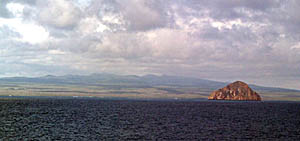|
|
  TODAY'S WEATHER Partly Cloudy 78.8°F (26°C) Latitude: 0 deg 45’S Longitude: 90 deg 18’W Wind Direction: S Wind Speed: 8 Knots Sea State: 1 Swell(s) Height: 2-4 Foot Sea Temperature: 80.6°F (27°C) Barometric Pressure: 1012 MB Visibility: 10-25 Nautical Miles  Breakfast Spanish Omelet Blueberry pancakes Quesadillas Cinnamon rolls Bacon and sausage Hash browns and oatmeal Sliced fruit Dry cereal Lunch BBQ Pork sandwiches Chili dogs Oven-glo potatoes Spanish soup Salad bar Butter cookies Dinner Savory baked chicken Sweet potatoes Rice and vegetables French bread Salad bar Pudding and cream In the steps of the HMS Beagle Almost 165 years ago, the HMS Beagle sailed up the channel between Isabela and Santa Cruz Islands carrying Charles Darwin to several of the islands in the Galapagos Archipelago. Today, we followed the same track as we left these beautiful islands to head north on the last leg of our expedition. Sailing by the young volcanic landscapes on these islands was like looking through the pages of a textbook on volcanoes! There was plenty of wildlife to watch too. Frigate birds, gulls, and boobies swooped and dived for small bait fish that scattered from the bow of RV Melville. Porpoises were herding tuna in the distance, but the ship was going too fast (over 13 knots) for our trolling lines to attract any fish. We have been at sea for over a month -- a long time to be away from home, loved-ones, and friends. One of the reasons we stopped in the Galapagos Islands was to let off two members of our science team who had to return to their universities for other pressing research projects. Rachel Haymon and Paul Johnson have been valued members of our expedition and we were sad to see them leave in Santa Cruz. We wish them a safe and speedy return home. For the rest of us, it is back to the open ocean after the change of pace that the few days working in the Galapagos Islands brought us. Soon we will begin working at the final mid-ocean ridge study site for this expedition -- the Galapagos Rift near 2° 08’N Latitude and 97° 34’W Longitude. There, we will be looking for evidence that a volcanic eruption occurred 18 months ago. Our data from the Autonomous Hydrophone Array indicate that a seismic event occurred then -- now we have to show that it was caused by volcanic activity.
We got a great view of the northwest coast of Santa Cruz Island as we sailed northwest up the Isabela Channel. Small islets, like the one in this picture, are havens for marine life and are some of the best SCUBA diving spots in the Galapagos Islands. As I write this journal, RV Melville is steaming northwest at 13.5 knots. If we maintain this speed, we will get to our survey area in the early morning hours of Wednesday, 26 April. In the meantime, we are planning our strategy for the DSL-120 sonar and Argo II surveys that we will do in that area. Check in tomorrow for more details on the next survey site and what we plan to do.
|
|||||||||||||||||||||||||||||||||||||||||||||||||||||||||||||||||||||||||||||||||||||||||||||||||||||||||||||||||||||||||||||||||||||||||||||||||||||||||||||||||||
© 2010 Dive and Discover™. Dive and Discover™ is a registered trademark of
Woods
Hole Oceanographic Institution

